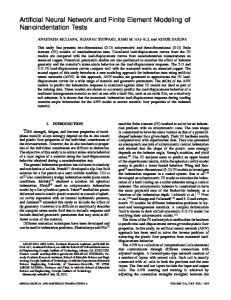A Finite Element Study on the Nanoindentation of Thin Films
- PDF / 66,851 Bytes
- 6 Pages / 612 x 792 pts (letter) Page_size
- 34 Downloads / 403 Views
A Finite Element Study on the Nanoindentation of Thin Films Xi Chen and Joost J. Vlassak Division of Engineering and Applied Sciences, Harvard University, Cambridge, MA 02138, U.S.A. ABSTRACT Nanoindentation is a technique commonly used for measuring thin film mechanical properties such as hardness and stiffness. Typically, shallow indentations with contact depths less than 10-20% of the film thickness are used to ensure that measurements are not affected by the presence of the substrate. In this study, we have used the finite element method to investigate the effect of substrate and pile-up on hardness and stiffness measurements of thin film systems. We find that: i) for soft films on hard substrates, the hardness is independent of the substrate as long as the indentation depth is less than 50% of the film thickness; ii) as soon as the hardness exceeds that of the substrate, the substrate effect becomes significant, even for indentations as shallow as 5% of the film thickness; iii) if the film is at least 40 times harder than the substrate, the plastic zone is mostly confined to the substrate while the film conforms to the deformed substrate by bending. We define a substrate effect factor and construct a map that may be useful in the interpretation of indentation measurements on thin films. It is found that the yield stress mismatch is a key factor characterizing the hardness of thin film system, and the elastic mismatch is important when making stiffness measurements. The results obtained in this study are very useful when it is difficult to avoid the influence of the substrate on the measurements. INTRODUCTION Industry has long relied on indentation techniques for measuring the hardness and stiffness of a wide range of bulk materials. Recently, nanoindentation techniques have been used to study the mechanical properties of thin films on substrates [1, 2]. In industry, indentations with contact depths of less than 10-20% of the film thickness are needed in order to obtain intrinsic film properties and to avoid the so-called substrate effect [3]. This is often not practical as the thickness of films used in many applications continue to decrease. In the microelectronics industry, for instance, film thicknesses of a few tens of nanometers are not uncommon [2]. Due to experimental equipment limitations it seems that in such cases it is inevitable for the substrate to affect the final measurements. Several analytical approaches have been developed for measuring mechanical properties from indentation load-displacement data of a bulk material [1, 4]. The analytical model developed by Hill [5] leads to the famous relationship between hardness H and yield strength σ y of an elastic-perfectly plastic bulk material: H = P / A = cσ y
(1)
Here, the hardness H is defined as the ratio between the indentation load P and the projected contact area A , and c is the constraint factor that is a constant for a given material, and it depends on the indenter angle and the yield strain of the bulk material [6]. Based on an elastic unl
Data Loading...










